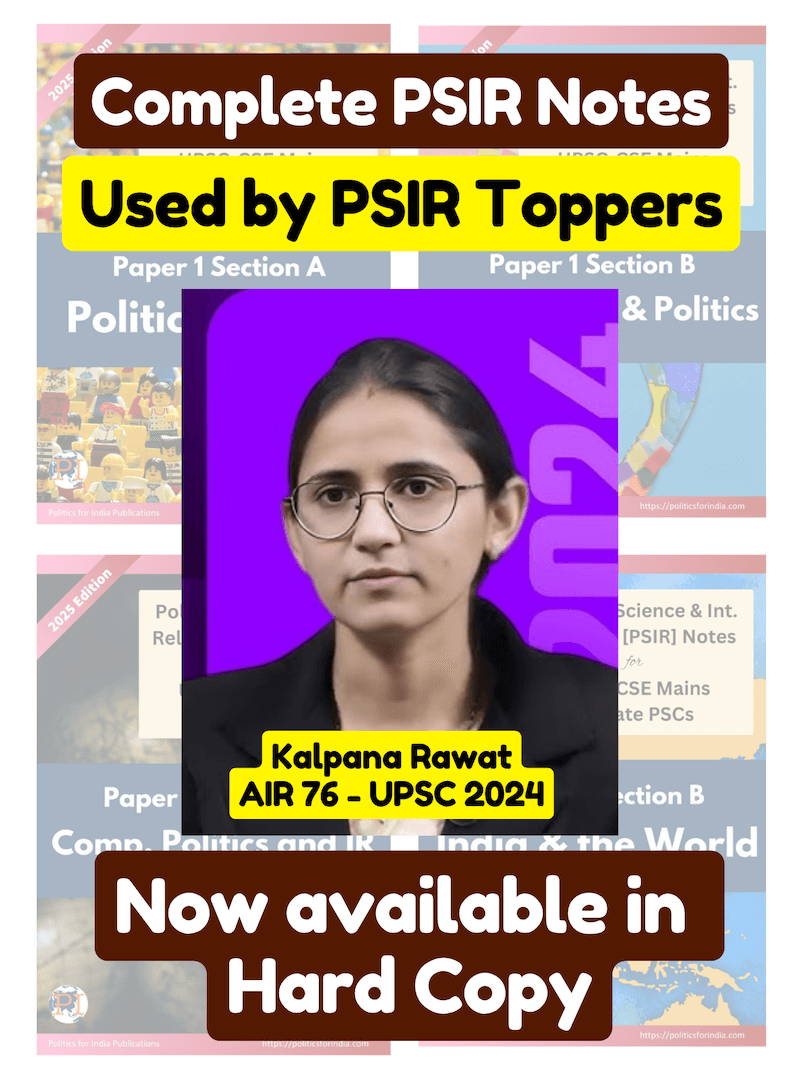While evaluating answers in a Test Series, I often tend to observe some mistakes which feel very obvious to avoid. While I do mention things in feedback, its difficult to give details about everything in that space.
Further, it also left me wondering – how many students must be losing our marks, just because they don’t know such simple aspects of answer writing. For this reason, we thought of compiling all such Frequently Asked Questions regarding PSIR Answer writing or the basics that all of you must be aware of.
As you must have realized over time, writing high-scoring answers in PSIR Optional isn’t merely about knowledge—it’s about presentation as well as articulation.
Whether you’re a first-time writer or refining your approach, these insights will help you write cleaner, sharper, and more effective PSIR answers that actually fetch marks. Feel free to comment if you feel something else can also be added.
1. Ideal Answer Length for PSIR Optional
In PSIR Optional, UPSC prescribes word limit only for 10 mark-questions (150 words). You get 2 pages for 10 mark-questions. For 15 and 20 mark-questions, you get 3 and 4 pages respectively, with no prescription about maximum number of words.
In practice, it’s acceptable to exceed the limit slightly (by, say, 5-10%).
Considering all these, it is suggested to write about 80 words /page. If your handwriting is big/small, you should adjust spacing in a way that overall answer looks good.
Try using the available space fully – writing “end-to-end” so it creates a good impression. Also, remember that quality matters over sheer quantity – don’t fill pages with fluff just to increase word count. At times, if you don’t have much to write, you can wrap up your answers early and give time to other questions.
2. Paragraphs vs Points in PSIR Answers
For PSIR optional, paragraph form is generally preferred. Unlike GS answers, which often use bullet points, PSIR answers should read more like a brief academic discussion. Writing in well-structured small paragraphs (about 3-5 lines each) keeps the answer scholarly in tone.
You should also maintain a logical flow of argument, which is crucial in PSIR.
That said, you can mix in a few bullet points or numbered points within an answer if the question demands enumeration (for example, 3 principles of justice by Rawls) – but do so sparingly.
The overall presentation should still feel like a coherent exposition rather than a list. You need to come across as an expert, almost as if writing a focused mini-essay.
To improve readability, you should break long paras into multiple short paragraphs, each covering a specific dimension of the answer.
Also, avoid use of headings to different parts of answer, as far as possible.
3. Structure of Introduction and Conclusion
Every PSIR answer should have a brief introduction and conclusion – both are must-haves.
The introduction is typically a single short paragraph (perhaps 2-3 sentences) that directly addresses the question’s theme. It can be of two paras for 20 mark questions.
In those first lines, you might define a key term, provide context, or quote a relevant theory to set the stage. If the question is complex – you should just simplify the question in introduction.
There’s usually no need for a very long intro; avoid wasting too many words here. If you struggle to craft a fancy opening, a simple, general statement related to the question is fine to begin with – just ensure it’s relevant.
The conclusion should also be concise – spanning 2-3 sentences. A conclusion might link back to the introduction or comment on the discussion you had in the body of the answer.
Overall, intro and conclusion should each take up 10-15% of total words allowed for the answer.
And yes, if you don’t know much about the core part of answer – you can write long intros or conclusions just to fill up the space.
4. Underlining Key Words
Underlining important words or phrases is a common practice to draw the examiner’s attention to your key points. It is recommended to underline selectively – for example, names of scholars, important concepts, constitutional articles, or any “catchphrase” in your answer that is crucial to your argument.
This helps the evaluator quickly see that you’ve mentioned critical keywords (which they often scan for).
However, do not overdo it. If you underline too many things, nothing stands out and the answer might look messy. Aim to underline only the core terms or arguments in each paragraph.
Many aspirants prefer to write the answer first and then underline during a quick review, so that underlining doesn’t break the flow of writing. Others lightly underline as they go – find what works in practice.
5. Diagrams, Tables, and Flowcharts in PSIR Answers
While PSIR is a text-heavy subject, diagrams or visual elements can be used judiciously to enhance your answer. If a diagram or flowchart can add value by simplifying a complex idea or showing relationships clearly, you should use it. It should not be used for sake of using it.
These tools are especially handy in International Relations (Paper II) – e.g., a map sketch to show India’s border clashes.
Tables should not be used for side-by-side comparisons or listing pros and cons.
6. Quoting Scholars: How Many and How to Manage
In PSIR answers, bringing in scholars’ views or theories is highly valued because it lends a scholarly touch. However, this doesn’t mean you must have a direct quote every time.
It’s not compulsory to stuff every answer with multiple quotations if the question doesn’t demand it. In fact, some toppers have scored well even in answers without quotes, simply by explaining concepts effectively. Scholars aren’t everything… You must do justice to the question.
Also, if you forget the exact wording of a quote, it’s perfectly fine to paraphrase the idea in your own words and attribute it to the thinker. The examiner will still appreciate the reference.
Also, make sure the scholar you quote is relevant to the question’s context – quoting randomly won’t fetch marks.
Lastly, you can also prepare a repository of a few important scholars per topic (with their key ideas or one-liners), so you’re ready to deploy them when needed.
7. Tackling Questions You Don’t Fully Understand
It’s not uncommon in PSIR to face a question that seems unfamiliar or confusing. In such cases, it is usually better to attempt something reasonable than to leave it blank. An unanswered question is a guaranteed zero, whereas a partially correct attempt might fetch a few crucial marks.
The first step is to break down the question: identify any keywords or themes you recognize. Try to relate it to something you’ve read – perhaps a known theory, a thinker’s perspective, or a contemporary example that fits.
This strategy ensures that even if you aren’t directly hitting the exact point of an obscure question, you’re at least writing relevant material in a political science context.
Structurally, maintain intro-body-conclusion format to show a coherent attempt. Evaluators can give some marks for a logically structured answer that addresses the theme, even if it isn’t a perfect answer to the question.
Those extra 1-2 marks you earn by attempting a tough question can make a difference. If truly stumped, you might write a broad overview related to the topic and conclude briefly.
8. Using Hindi or Sanskrit Terms in Answers
Using Hindi or Sanskrit terms occasionally can add a nice touch to your answers, especially if they capture an idea succinctly or are the exact name of a concept/policy. In PSIR, you might find opportunities to include famous phrases like “Vasudhaiva Kutumbakam” (the world is one family) in an IR context, or mention Indian concepts like “dharma” or “Ram Rajya” when relevant.
This is perfectly okay – UPSC answers need not be devoid of Indian languages as long as the usage is appropriate and understood. In fact, many aspirants prepare a few Sanskrit quotes or Hindi slogans to sprinkle in essays or ethics/optional answers for emphasis.
Also, don’t overuse non-English terms – your answer should not become cryptic. A phrase or two in an answer is sufficient. The medium of the exam is still English, so the bulk of your answer must be intelligible to an English speaker.
Using Hindi/Sanskrit mainly for proper nouns (schemes like “Beti Bachao, Beti Padhao”) or for famous quotes is the safest.
9. Using Abbreviations (IR, USA, SC, etc.)
Abbreviations are generally acceptable in PSIR, as long as they are commonly known or you’ve defined them initially. For instance, writing “USA” instead of “United States of America,” “UN” for United Nations, “SC” for Supreme Court or Security Council (depending on context), or “IR” for International Relations is perfectly fine.
However, a few guidelines: if an abbreviation is very common (widely used in news and books) – like GDP, NATO, EU, USSR, NGOs – you can use it directly. If it’s less obvious or specific to the subject, it’s safer to introduce it by its full form once and then use the short form thereafter. For example, you might write “Constructivism in IR (International Relations)…” at first use, and then just “IR” subsequently. This way you ensure the examiner knows what you mean by the acronym.
Also, avoid creating your own ambiguous acronyms on the fly.
Also, ensure that in a single answer, if you use many abbreviations, you don’t over-clutter the answer making it look like an alphabet soup. Clarity is king. So use abbreviations for efficiency, but not at the cost of clarity.
Just maintain consistency and ensure your abbreviations are commonly used or explained. This will make your answer succinct and easy to read.
10. Common Mistakes in PSIR Answers (Red Flags for Examiners)
There are several recurring pitfalls that PSIR candidates should be wary of when writing answers. Being aware of these common mistakes can help you avoid the red flags that evaluators notice:
- Not addressing the question’s demand: A very common error is writing a generic answer that tangentially relates to the topic but doesn’t specifically answer what was asked.
- Lack of theoretical integration: In PSIR, failing to mention relevant theories or scholars is a missed opportunity. A good answer should invoke the thinkers or theoretical frameworks pertinent to the question. You can refer our current affairs articles for more illustration in this regard.
- Overloading current examples without analysis: While examples (especially current affairs or case studies) are useful, another mistake is to let them dominate the answer at the expense of analysis. Some candidates, in an effort to show awareness, keep listing facts or recent events without tying them to the political science concept asked. Examiners might see this as lack of deeper insight. Balance is key: use examples to support arguments, not to replace them.
- One-sided arguments: Writing an answer that is entirely one-dimensional (all positive or all negative, ignoring counterpoints) is a pitfall. PSIR questions often demand a balanced analysis or a critical approach. Always try to include multiple perspectives – if you argue one side, acknowledge the other. For instance, if asked about democracy’s merits, also note its challenges, and vice versa. An answer devoid of any counter-argument is considered analytically weak.
- Poor organization and presentation: If an answer is haphazard – no clear intro/conclusion, no logical flow – it frustrates the examiner. Sloppy handwriting or very dense paragraphs without breaks can be a red flag. Essentially, “poor presentation”– makes the answer less reader-friendly.
- Missing key keywords or examples: PSIR examiners often have certain “keywords” in mind for topics. For example, in an answer on Marxism, terms like “dialectical materialism,” “surplus value,” etc., are expected. Similarly, not mentioning a crucial case study or relevant current event can be a mistake in an IR question (e.g., omitting mention of QUAD in a question on Indo-Pacific strategy). The solution is to revise syllabus topics thoroughly and know the buzzwords for each.
11. How Does Handwriting Matter in UPSC‑CSE and PSIR Optional?
According to UPSC notifications:
“If a candidate’s handwriting is not easily legible, a deduction will be made on this account from the total marks otherwise accruing to the candidate.”
“Suitable deduction of marks may be made for bad handwriting. Where the handwriting is illegible and the written matter in the subjective view of the examiner cannot be evaluated, no credit will be given.”
This means that even a well-structured answer, brimming with theory, examples, and analysis, could lose value if the examiner struggles to read it. Clarity in writing ensures your knowledge isn’t held hostage by sloppy penmanship.
While you don’t need calligraphy-level beauty, readability is non-negotiable. If you don’t have a good handwriting, working steadily on it will ensure that your hard-earned knowledge is not undermined by illegibility.
12. Making Your PSIR Answer Stand Out
In a competitive exam like UPSC, distinctiveness in your answers can fetch extra credit. Here are some practical ways to make your PSIR answers stand out from the rest.
- Use the language of Political Science: Your answer should read like it’s written by a political science specialist, not a generalist. This means employing the proper terminology, theory references, and analytical style that a student of PSIR would use. You must appear to the examiner as “a serious student of the subject rather than a layman”.
- Interlinkages and multi-dimensional analysis: An outstanding PSIR answer often draws connections across different areas of the syllabus and even between theory and current events. For instance, you could use a theoretical concept from Paper I to illuminate an IR issue in Paper II. These cross-linkages stand out because they show you’ve internalized the subject as a whole, not in silos.
- Provide insightful analysis: A standout answer doesn’t just enumerate points – it provides insight. If you can include a subtle analysis or a unique angle that others might miss, it catches attention.
Consistent use of all the above elements – scholarly language, inter-linkages, balanced insight, etc. – will inevitably make your PSIR answers stand out to the examiner. It signals that you are not only well-prepared but also genuinely interested and proficient in the subject. And that is often the hallmark of a top scorer in the optional.
















Sir, Please tell how to write good answers like you did in your model answers. There is a big difference between PSIR usual notes and the style of writing answers in the actual exam.